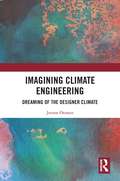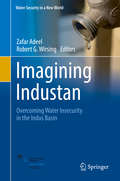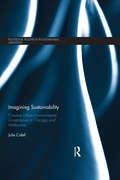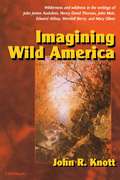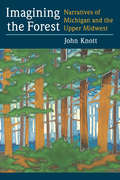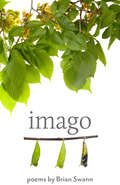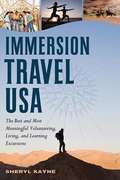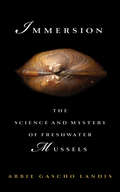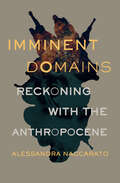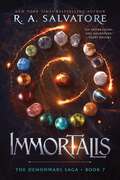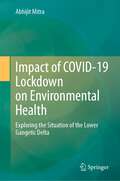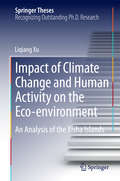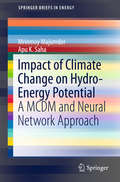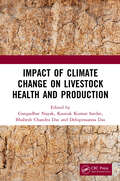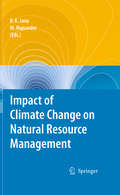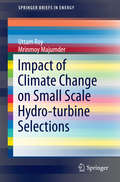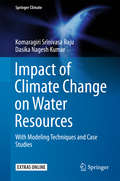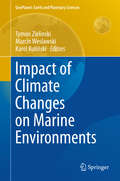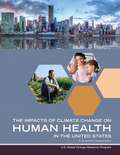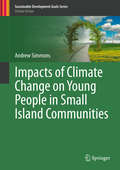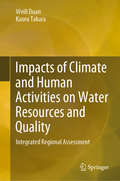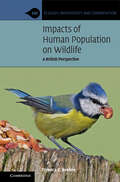- Table View
- List View
Imagining Climate Engineering: Dreaming of the Designer Climate
by Jeroen OomenThis book highlights the increasing attention for climate engineering, a set of speculative technologies aimed to counter global warming. What is the future of the global climate? And who gets to decide—or even design—this future? Imagining Climate Engineering explores how and why climate engineering became a potential approach to anthropogenic climate change. Specifically, it showcases how views on the future of climate change and climate engineering evolved by addressing the ways in which climate engineers view its respective physical, political, and moral domains. Tracing the intellectual and political history of dreams to control the weather and climate as well as the discovery of climate change, Jeroen Oomen examines the imaginative parameters within which contemporary climate engineering research takes place. Introducing the analytical metaphor ‘ways of seeing’ to describe explicit or implicit visions, understandings, and foci that facilitate a particular understanding of what is at stake, Imagining Climate Engineering shows how visions on the knowability of climate tie into moral and political convictions about the possibility and desirability of engineering the climate. Marrying science and technology studies and the environmental humanities, Oomen provides crucial insights for the future of the climate change debate for scholars and students.
Imagining Industan
by Zafar Adeel Robert G. WirsingThis volume calls upon over a dozen Indus observers to imagine a scenario for the Indus basin in which transboundary cooperation over water resources overcomes the insecurity arising from water dependence and scarcity. From diverse perspectives, its essays examine the potential benefits to be gained from revisiting the 1960 Indus Waters Treaty, as well as from mounting joint efforts to increase water supply, to combat climate change, to develop hydroelectric power, and to improve water management. The Indus basin is shared by four countries (Afghanistan, China, India, and Pakistan). The basin's significance stems in part simply from the importance of these countries, three of them among the planet's most populous states, one of them boasting the world's second largest economy, and three of them members of the exclusive nuclear weapons club. However, the basin's significance stems also from the great importance of the Indus waters themselves - due especially to the region's massive dependence on irrigated agriculture as well as to the menace of climate change and advancing water scarcity. The "Industan" this volume imagines is a definite departure from business as usual responses to the Indus basin's emerging fresh water crisis. The objective is to kindle serious discussion of the cooperation needed to confront what many water experts believe is developing into one of the planet's most gravely threatened river basins. It is thus both assessment of the current state of play in regard to water security in the Indus basin and recommendation about where to go from here.
Imagining Sustainability: Creative urban environmental governance in Chicago and Melbourne (Routledge Research in Sustainable Urbanism)
by Julie CidellCities, rather than nations, have become the key sites for enacting environmental policies. This is due to the combination of growing urban populations and increased action on the part of local governments (generally attributed to national governments’ failure to act on climate change). Imagining Sustainability seeks to understand how actors in local government conceptualize sustainability and their role in producing it, and what difference that understanding makes to their physical, political, and social environments now and in the future. International comparisons can uncover new ideas and possibilities. Chicago and Melbourne are prime candidates for such a comparison: they are cities of the same age, they have similar historical trajectories as interior gateways followed by industrial growth and then deindustrialization, and they have demonstrated the same recent desire to be global champions of sustainability. Based on qualitative fieldwork in these two cities, this book uses Karen Barad’s methodology of diffraction to read these case studies through each other. This methodology helps to understand not only what differences exist between these two places, but what effects those differences have on the urban environment. This book will be of great interest to students and scholars of urban studies, urban planning and environmental policy and governance.
Imagining Wild America
by John R. KnottAt a time when the idea of wilderness is being challenged by both politicians and intellectuals,Imagining Wild Americaexamines writing about wilderness and wildness and makes a case for its continuing value. The book focuses on works by John James Audubon, Henry David Thoreau, John Muir, Edward Abbey, Wendell Berry, and Mary Oliver, as each writer illustrates different stages and dimensions of the American fascination with wild nature. John Knott traces the emergence of a visionary tradition that embraces values consciously understood to be ahistorical, showing that these writers, while recognizing the claims of history and the interdependence of nature and culture, also understand and attempt to represent wild nature as something different, other. A contribution to the growing literature of eco-criticism, the book is a response to and critique of recent arguments about the constructed nature of wilderness. Imagining Wild Americademonstrates the richness and continuing importance of the idea of wilderness, and its attraction for American writers. John R. Knott is Professor of English, University of Michigan. His previous books includeThe Huron River: Voices from the Watershed,coedited with Keith Taylor.
Imagining the Forest // Narratives of Michigan and the Upper Midwest
by John Knott"Forests have always been more than just their trees. The forests in Michigan (and similar forests in other Great Lakes states such as Wisconsin and Minnesota) played a role in the American cultural imagination from the beginnings of European settlement in the early 19th century to the present. Our relationships with those forests have been shaped by the cultural attitudes of the times, and people have invested in them both moral and spiritual meanings. Author John Knott draws upon such works as Simon Schama's Landscape and Memory and Robert Pogue Harrison's Forests: The Shadow of Civilization in exploring ways in which our relationships with forests have been shaped, using Michigan-its history of settlement, popular literature, and forest management controversies-as an exemplary case. Knott looks at such well-known figures as William Bradford, James Fenimore Cooper, John Muir, John Burroughs, and Teddy Roosevelt; Ojibwa conceptions of the forest and natural world (including how Longfellow mythologized them); early explorer accounts; and contemporary literature set in the Upper Peninsula, including Jim Harrison's True North and Philip Caputo's Indian Country. Two competing metaphors evolved over time, Knott shows: the forest as howling wilderness, impeding the progress of civilization and in need of subjugation, and the forest as temple or cathedral, worthy of reverence and protection. Imagining the Forest shows the origin and development of both"--
Imago (Johns Hopkins: Poetry and Fiction)
by Brian SwannAn exuberant collection of poems celebrating art, nature, and humanity.This various and vital poetry collection, in rich language and sharp detail, spans the rural and urban, country and town, and foreign and domestic. Tracing the vagaries of the self, these poems record and transmute biography from an English youth to the trials and challenges of aging in America. Memorable for its exuberant voice and exacting eye, Brian Swann's Imago is awake to the natural world as well as the world within. From the half-page title poem to the multi-section "Elegiac," this volume is striking in its largeness, its tone evolving from self-indicting to ecstatic and self-transcendent. This collection, the author's fourteenth, is moving both as art and as testament.Imago unfolds much like a piece of music. It is a continuum by which Swann sees nature and art interwoven in the ways they emerge and change. In "Grief and Magritte," Swann muses upon "all of us snagged in a net whose skeins tangle in night sky / where one star dreams another." The title poem focuses on an insect "on its way through the changes, the patterns / of what led up to it, the catches and releases . . . saying now, and now" till "splitting down the back" such changes "release what was always there." Brian Swann's poems, moving in their candor, read as though they have always been there, too.
Imayamalai
by S. MohanaThe book gives the mythological, historical and geographical details of the Himalayas, the great mountain of India.
Immersion Travel U.S.A.: The Best and Most Meaningful Volunteering, Living, and Learning Excursions
by Sheryl KayneImmersion travel is for everyone at all ages and stages of life. It means taking an active part in where you visit in order to learn about the culture, traditions, and characteristics of each particular place. Designed to be a resource and idea book, this guide provides practical information about immersion travel, special considerations and costs, and how to plan and take vacations, sabbaticals, side trips, and more.
Immersion: The Science and Mystery of Freshwater Mussels
by Abbie Gascho LandisAbbie Gascho Landis first fell for freshwater mussels while submerged in an Alabama creek, her pregnant belly squeezed into a wetsuit. After an hour of fruitless scanning, a mussel materialized from the rocks—a little spectaclecase, herself pregnant, filtering the river water through a delicate body while her gills bulged with offspring. In that moment of connection, Landis became a mussel groupie, obsessed with learning more about the creatures' hidden lives. She isn't the only fanatic; the shy mollusks, so vital to the health of rivers around the world, have a way of inspiring unusual devotion.In Immersion: The Science and Mystery of Freshwater Mussels, Landis brings readers to a hotbed of mussel diversity, the American Southeast, to seek mussels where they eat, procreate, and, too often, perish. Accompanied often by her husband, a mussel scientist, and her young children, she learned to see mussels on the creekbed, to tell a spectaclecase from a pigtoe, and to worry what vanishing mussels—70 percent of North American species are imperiled—will mean for humans and wildlife alike. In Immersion, Landis shares this journey, traveling from perilous river surveys to dry streambeds and into laboratories where endangered mussels are raised one precious life at a time.Mussels have much to teach us about the health of our watersheds if we step into the creek and take a closer look at their lives. In the tradition of writers like Terry Tempest Williams and Sy Montgomery, Landis gracefully chronicles these untold stories with a veterinarian's careful eye and the curiosity of a naturalist. In turns joyful and sobering, Immersion is an invitation to see rivers from a mussel's perspective, a celebration of the wild lives visible to those who learn to search.
Imminent Domains: Reckoning with the Anthropocene
by Alessandra NaccaratoImminent Domains: Reckoning with the Anthropocene invites readers to join a contemplation of survival—our own, and that of the elements that surround us. Using research, lyric prose, and first-hand experiences, Alessandra Naccarato addresses fundamental questions about our modern relationship to nature amidst depictions of landscapes undergoing dramatic transformation.We trace the veins of harm, memory and meaning amongst ecosystems and bioregions; through history and across continents, from the mines of Cerro Rico to the ruins of Pompeii. Arranged by five central elements of survival—earth, fire, water, air and spirit—these essays refute linearity, just as nature does.Naccarato offers not blanket answers about our future, but rather myriad ways to find our own, individual response to an imminent question. We are being called to work together; to dig a trench deep and wide enough that the fires around us might stay at bay. How do we turn towards the fire?
Immortalis: The DemonWars Saga, Book 7 (DemonWars series #7)
by R. A. SalvatoreIn this extraordinary third and final work in the second DemonWars trilogy, R. A. Salvatore weaves a diverse tapestry of characters and events from all novels of the series into an epic, unforgettable conclusion as a dark young king is driven by a quest to remake humankind.In Honce-the-Bear, King Aydrian Boudabras wakes in a cold sweat, his conscience haunted by those he has killed in order to garner power, including the rightful king before him, Danube, his mother&’s husband. Now, Aydrian is preparing his armies for war, forging loyalties, playing one adversary against another, and giving those around him barely a glimpse at his remarkable powers. In the neighboring Behren, the evil Yatol Bardoh is unleashing a war engine of his own, using armies of mercenaries and horrific tactics to bring down the walls of Jacintha and to drive a ferocious dragon from the city of Dharyan. Between these two men, an explosive chain of events has been set into motion. Refugees flood the roads and valleys, alliances are formed and broken, navies clash at sea, and assassins seek their moment to strike. With Aydrian&’s power and popularity turning into an avalanche and the courageous Byrnn Dharielle valiantly standing in the way of the Yalot Bardoh, the great players in the DemonWars saga will unite and clash on a single, magnificent stage. In book three of the second DemonWars trilogy, #1 New York Times bestselling author R. A. Salvatore concludes the second trilogy and gathers the whole arc of the seven books of the DemonWars saga in a stunning conclusion that Kirkus Reviews claims &“fans will dance with joy&” to experience.
Impact of COVID-19 Lockdown on Environmental Health: Exploring the Situation of the Lower Gangetic Delta
by Abhijit MitraThis book examines the impacts that the COVID-19 lockdown has had on environmental and ecological health, with a focus on coastal ecosystems in the Lower Gangetic Delta. The book begins with an overview of COVID-19's spread and impact before and after the lockdown in the focus region, then addresses the specific impacts that the lockdown period had and continues to have on air quality, marine and estuarine water quality, coastal biodiversity, and the livelihoods of the region's inhabitants, especially those who live below the poverty line. The decrease in human activity combined with the complete closure of various sectors, including air travel, oil and gas drilling, and construction, has had a pronounced effect on biodiversity and overall environmental health that is yet to be fully realized. The book sheds light on these changes and assesses how biodiversity, ambient air quality, and ecosystem functioning will progress as COVID-19 remains a threat and the lockdown persists. The study will be of interest to researchers, government officials and professionals dealing with disaster management, environmental science, biological science, and health.
Impact of Climate Change and Human Activity on the Eco-environment
by Liqiang XuThis study describes the fundamentals of assessing the vulnerability of coral islands, as well as environmental management and resource exploitation. Using seabird subfossils, such as bones, guano, eggshells etc. , which have been well preserved on the Xisha Islands in the South China Sea, the author identifies the influences of climate change and human activity on seabird populations and diets. Understanding the past is of great importance for predicting the future, and seabird subfossils provide valuable information, which can be used to study changes in seabird ecology, paleoceanography and palaeoclimate. Furthermore, this study proposes examining the biogeochemical cycling of some elements present in the geosphere, hydrosphere, biosphere and atmosphere. Dr. Liqiang Xu works at the Hefei University of Technology, China.
Impact of Climate Change on Hydro-Energy Potential
by Mrinmoy Majumder Apu K. SahaThis Brief presents the impact of climatic abnormalities on hydropower potential of different regions of the World. In this regard, multi-criteria decision making and neural network are used to predict the impact of the change cognitively by an index. The results from the study show that the hydro-energy potential of the Asian region is mostly vulnerable with respect to other regions of the World. The model results also encourage further application of the index to analyse the impact of climate change on potential of hydro-energy.
Impact of Climate Change on Livestock Health and Production
by G D Nayak K K Sardar B C Das D P DasThis volume of 30 chapters contributed by reputed authors covers: Diversification of livestock and crops. Integration of livestock systems with forestry and crop production. Drought and heat wave tolerant varieties. Strategies for reduction of Green House Gases emission from ruminants. Application of GIS and remote sensing technologies. Breeds with inherent genetic capabilities to adapt to climate change. This book also takes into account the climate change adaptation, mitigation practices, and policy frameworks for promotion of sustainable livestock and poultry production. This book is co-published with NIPA. Taylor and Francis does not sell or distribute its print and electronic editions in India, Pakistan, Nepal, Bhutan, Bangladesh and Sri Lanka.
Impact of Climate Change on Natural Resource Management
by Mrinmoy Majumder Bipal Kr. JanaAs climate change takes hold, there is an ever-growing need to develop and apply strategies that optimize the use of natural resources, both on land and in water. This book covers a huge range of strategies that can be applied to various sectors, from forests to flood control. Its aim, as with resource management itself, is to combine economics, policy and science to help rehabilitate and preserve our natural resources. Beginning with papers on carbon sequestration, including the practice of artificial desertification, the topics move on to cover the use of distributed modeling and neural networks in estimating water availability and distribution. Further chapters look at uncertainty analysis applied to the spatial variation of hydrologic resources, and finally the book covers attempts at estimating meteorological parameters in the context of hydrological variables such as evapo-transpiration from stream flow. Within the next decade, the effects of climate change will be severe, and felt by ordinary human beings. This book proposes a raft of measures that can mitigate, if not reverse, the impact of global warming on the resources we have all come to depend on.
Impact of Climate Change on Small Scale Hydro-turbine Selections
by Mrinmoy Majumder Uttam RoyHydropower is found to be one of the most reliable and inexpensive options for renewable energy which was now widely been adopted by many countries to substitute fossil fuel sources. This Brief highlights the impact of climate change on hydropower plants, especially on the turbine design, as turbines are responsible for optimal conversion and regular energy production. The vulnerability of turbines is analyzed with the help of Artificial Neural Networks, followed by Multi Criteria Decision Making methods for development of intelligent indices to represent the level of vulnerability of turbines due to the change in climate.
Impact of Climate Change on Water Resources: With Modeling Techniques and Case Studies (Springer Climate)
by Komaragiri Srinivasa Raju Dasika Nagesh KumarThis book gives an overview of various aspects of climate change by integrating global climate models, downscaling approaches, and hydrological models. It also covers themes that help in understanding climate change in a holistic manner. The book includes worked-out examples, revision questions, exercise problems, and case studies, making it relevant for use as a textbook in graduate courses and professional development programs. The book will serve well researchers, students, as well as professionals working in the area of hydroclimatology.
Impact of Climate Changes on Marine Environments
by Tymon Zielinski Marcin Weslawski Karol KulińskiThis book contributes to the current discussion on global environmental changes by discussing modifications in marine ecosystems related to global climate changes. In marine ecosystems, rising atmospheric CO2 and climate changes are associated with shifts in temperature, circulation, stratification, nutrient input, oxygen concentration and ocean acidification, which have significant biological effects on a regional and global scale. Knowing how these changes affect the distribution and abundance of plankton in the ocean currents is crucial to our understanding of how climate change impacts the marine environment. Ocean temperatures, weather and climatic changes greatly influence the amount and location of nutrients in the water column. If temperatures and currents change, the plankton production cycle may not coincide with the reproduction cycle of fish. The above changes are closely related to the changes in radiative forcing, which initiate feedback mechanisms like changes in surface temperature, circulation, and atmospheric chemistry.
Impact of Urbanization on Water Shortage in Face of Climatic Aberrations
by Mrinmoy MajumderThe uncontrolled utilization of natural resources to supply to the water demands of the ever-growing population has brought about worldwide scarcity. The supply shortage has resulted in conflicts between countries, created prolonged drought, closing of industrial units, shifting of local inhabitants etc. The abnormality in climatic patterns due to global warming has only enhanced the uncertainties. Unregulated discharge of waste water into fresh water resources is also polluting the available water resources and making them non-utilizable. That is why the discrepancy between water supply and demand is slowly but steadily becoming a problem, which may lead to conflict and inequality all over the world. The present investigation is an attempt to find the impact of urbanization in the face of climatic uncertainties on water shortage or scarcity. How is climate responsible? What urbanization factors have an influence on the extent of shortages? What is the role of the socio-economic status of the inhabitants? Industrialization? Consumption pattern? Each of the causes and effects were analyzed with the help of data from a climate model, which was then fed into a hydrologic model. The hydrologic output data was then put into various other novel simulation platforms to predict the uncertainties that can be caused by urbanization in various sectors of the regions of interest. The impact was calculated based on IPCC recommended climatic and five distinct urbanization scenarios. The study results will help to predict what is in store of those living in the developing countries. Possible mitigation measures are also discussed.
Impacts of Climate Change on Allergens and Allergic Diseases
by Paul J. BeggsClimate change has been identified as the biggest global health threat of the twenty-first century. Hundreds of millions of people around the world currently suffer from allergic diseases such as asthma and allergic rhinitis (hay fever), and the prevalence of these diseases is increasing. This book is the first authoritative and comprehensive assessment of the many impacts of climate change on allergens, such as pollen and mould spores, and allergic diseases. The international authorship team of leaders in this field explore the topic to a breadth and depth far beyond any previous work. This book will be of value to anyone with an interest in climate change, environmental allergens, and related allergic diseases. It is written at a level that is accessible for those working in related physical, biological, and health and medical sciences, including researchers, academics, clinicians, and advanced students.
Impacts of Climate Change on Human Health in the United States: A Scientific Assessment
by US Global Research ProgramAs global climate change proliferates, so too do the health risks associated with the changing world around us. Called for in the President’s Climate Action Plan and put together by experts from eight different Federal agencies, The Impacts of Climate Change on Human Health: A Scientific Assessment is a comprehensive report on these evolving health risks, including: Temperature-related death and illnessAir quality deteriorationImpacts of extreme events on human healthVector-borne diseasesClimate impacts on water-related IllnessFood safety, nutrition, and distributionMental health and well-being This report summarizes scientific data in a concise and accessible fashion for the general public, providing executive summaries, key takeaways, and full-color diagrams and charts. Learn what health risks face you and your family as a result of global climate change and start preparing now with The Impacts of Climate Change on Human Health.
Impacts of Climate Change on Young People in Small Island Communities (Sustainable Development Goals Series)
by Andrew SimmonsThis book presents a comprehensive overview of the history, definition, causes, effects, impacts and implications of climate change on young people globally, with a focus on Small Island Communities (SIDS) in particular. The text highlights the key problems associated with the impact of climate change on young people in SIDS, specifically its effects on socio-economic development and livelihoods, and explores the need for the development of a new conceptual framework to deal with building the resilience of the adaptive capacity of youth in SIDS. The book analyzes the strengths and weaknesses of the emerging phenomenon of Global Youth Climate Change Movements/Actions, and examines the management/governance challenges associated with the Movement in terms of its operational mechanism, mobilization strategies and its use of social media/technology to mobilize mass action. The text concludes with a recommendation for further research in this area as a way to understand how the Movement functions and its mechanism for implementation of future research.
Impacts of Climate and Human Activities on Water Resources and Quality: Integrated Regional Assessment (Springer Geography Ser.)
by Weili Duan Kaoru TakaraWith the rapid increase of world population, the global water shortage is set to be the major crises of the twenty-first century; that is, population dynamics (growth, age distribution, urbanization and migration) create pressures on freshwater resources due to the increased water demands and pollution. Moreover, water resources management faces a new uncertainty- i.e. the potential for longer-term and more persistent climate change nowadays, which, in coming years, may significantly affect the availability of supply and patterns of water demand. This book mainly focuses on the impact of climate change and human activities on water quality and water resources in Asia Countries. It begins by describing the characteristics of water related disasters in the world. Then, the book analyzes the changes of floods and associated socio-economic damages for whole China over the last century, and assesses water quality and pollution source for the Yangtze River Basin, suggesting water-related disasters would become more intense, longer lasting, and/or more frequent in a future warmer climate. Then, after investigating spatiotemporal trends and causes of water quality and water quality incidents (Chapter 4) and precipitation extreme events (Chapter 5) in Japan, subsequent two chapters mainly evaluate the climate and human impacts on precipitation variations, water quality and water resources in the Hokkaido area. The final chapter comprehensively analyzes climate change impacts on water resources in the Aral Sea Basin, and then estimate the water requirements and water deficits for irrigation, future agricultural yields of seven major crops, and land and water productivity in four provinces of Turkmenistan considering climate change, population growth, and three socio-economic development scenarios. All results obtained from this book may provide a means to reduce water quality incidents and mitigate future negative impacts by adapting water management. Furthermore, the improved methods for water quality modeling in data scarce regions are transferable to other study areas and applicable in future research.
Impacts of Human Population on Wildlife: A British Perspective (Ecology, Biodiversity and Conservation)
by Trevor J. BeebeeWildlife and the countryside are highly valued by people in the UK, and for good reason. Healthy habitats are invaluable assets and promote human wellbeing. However, they are under increasing threat from, among other things, relentless urban expansion and intensive modern agriculture. These pressures largely stem from a major underlying cause – the high and growing population of humans living in the UK. This book provides an overview of wildlife in the UK and its recent status; factors contributing to wildlife declines; trends in human numbers; international deliberations about the impacts of human population growth; and the implications for the future of wildlife conservation in the UK. The evidence-based text includes comparisons of wildlife declines and their causes in other countries, providing a global perspective. This book is for ecologists, naturalists and conservation biologists studying and working in academia or in consultancies, as well as all those interested in wildlife conservation.
